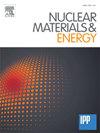The effect of divertor closure on the impurity stagnation point in detached L-mode discharges on DIII-D
IF 2.3
2区 物理与天体物理
Q1 NUCLEAR SCIENCE & TECHNOLOGY
引用次数: 0
Abstract
This paper presents experimental measurements of the location of the impurity flow stagnation point in the scrape-off-layer (SOL) of a tokamak plasma. Coherence imaging of carbon-2+ emission (465 nm) is used to track the main-chamber impurity velocity of DIII-D L-mode plasmas with out of the divertor. The flow stagnates near the top or crown of the plasma when an open divertor (no baffling) is used. In contrast, with matched conditions and using a divertor with baffling, the flow stagnates near the outer divertor leg (X-point). The poloidal emission is hollow, peaking near the divertor legs, in the open configuration. In contrast, in the closed configuration, the emission is flat through most of the main-chamber SOL. Changing divertor dissipation from attached to detached conditions had only a minor effect on the main-chamber midplane impurity velocity. Numerical simulations using the multi-fluid edge transport code UEDGE including cross-field drifts show qualitative agreement with the open divertor experimental result.
求助全文
约1分钟内获得全文
求助全文
来源期刊

Nuclear Materials and Energy
Materials Science-Materials Science (miscellaneous)
CiteScore
3.70
自引率
15.40%
发文量
175
审稿时长
20 weeks
期刊介绍:
The open-access journal Nuclear Materials and Energy is devoted to the growing field of research for material application in the production of nuclear energy. Nuclear Materials and Energy publishes original research articles of up to 6 pages in length.
 求助内容:
求助内容: 应助结果提醒方式:
应助结果提醒方式:


